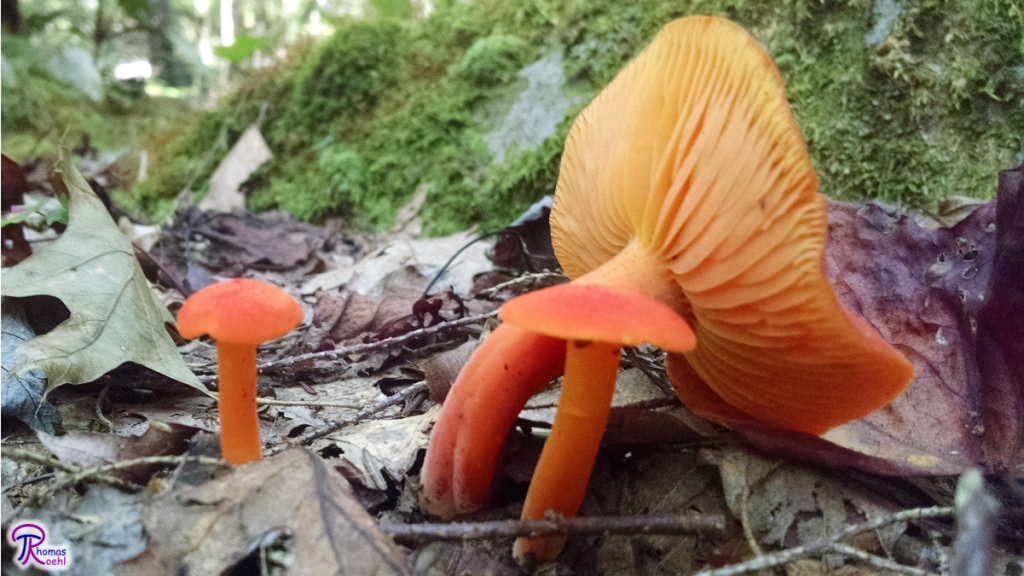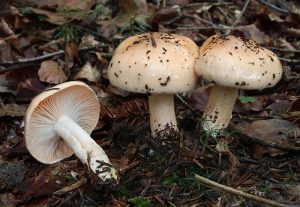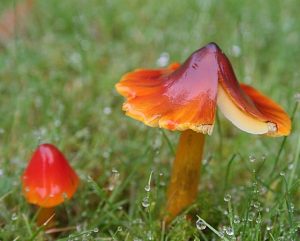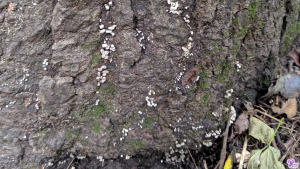#182: Waxy Caps

Waxy caps, like this Hygrocybe splendidissima, are known for their thick waxy gills. Species of Hygrocybe are generally small and brightly-colored.
The waxy caps (alternately called “wax caps” or “waxcaps”) are agaric mushrooms primarily distinguished by their waxy texture, as the name suggests. Actually, the gills are the only part of the mushroom that feels waxy. To fully appreciate the unusual texture, break off a small piece of the gills and roll it between your fingers. It should have a texture reminiscent of soft candle wax.1,2
Description
Waxy caps are umbrella-like gilled mushrooms and are small to medium in size. Depending on the species and age, the pileus is conic, hemispherical, or nearly flat. Pileus texture is an important feature and can be slimy, sticky, waxy, or dry. The stipe attaches to the center of the pileus and gills radiate out from that point. The stipe can also be slimy, sticky, or dry. Gill attachment is variable and ranges from attached to decurrent. The gills are thick and waxy and are often widely spaced. All waxy caps deposit a white spore print. The most well-known waxy caps are brightly-colored, but the group also contains many whitish mushrooms.2
The unifying feature of this group is the waxy texture of the gills.3 I don’t find this a particularly helpful characteristic because it is one of the last things to check on my list. When possible, I try to assess the mushroom without damaging it, just in case I accidently obscure some of its features in the process. This is especially important for fragile mushrooms or when I only collected a single specimen. Consequently, I usually identify the mushroom as a waxy cap before checking the gill texture. There is no good way to explain how to do this; you just have to become familiar with what waxy caps “normally” look like by finding and identifying a bunch of them.
Historically, there were two major groups of waxy caps: Hygrophorus and Hygrocybe. Classification has gotten much more complicated in recent years, but many field guides still use the old groups. In general, Hygrophorus species were medium-sized, were thick fleshed, and had dull colors. Hygrocybe species, on the other hand, were small, thin fleshed, and brightly colored (primarily with shades of yellow, orange, red, and white). Hygrophorus also tended to be slimier than Hygrocybe.2,3

Hygrophorus species, such as this H. pudorinus, are mycorrhizal and are generally larger and have duller colors than species of Hygrocybe. Photo by H. Krisp [CC BY 3.0], via Wikimedia Commons
Ecology
Waxy cap ecology is variable and poorly understood. The only genus whose ecology is worked out is Hygrophorus. Most species in the Hygrophorus are ectomycorrhizal with trees. Based on DNA evidence, Hygrophorus evolved an ectomycorrhizal habit independently of the other basidiomycetes, making it a stunning example of convergent evolution. One exception to this general rule is H. olivaceoalbus, which seems to interact parasitically with its tree symbionts.
The nutritional strategies of other waxy cap genera are not as clear. Many were assumed to be saprobic, but the fungi resist attempts at cultivation and contain isotope ratios more similar to the ratios in living plant tissue. Fungi that decay plant matter should be easy to cultivate because they extract all of their resources from the environment without any help. They should also have isotope ratios that reflect those found in decaying plant tissue, since most of the atoms found in the fungus would be extracted from molecules in the dead plant material. The waxy caps do not fit this pattern, so they must get their energy from somewhere else. Mycologists have not been able to pin down the nutritional strategy of non-Hygrophorus waxy caps, possibly because they get nutrients and energy from multiple sources. Based on what little evidence is available, mycologists have proposed that various species in the group are ectomycorrhizal, parasitic, saprobic, or endophytic. On top of that, mycologists think the non-Hygrophorus waxy caps form these relationships with a wide array of organisms: from trees to mosses to cyanobacteria.4
Waxy caps grow in a variety of habitats, but always appear on the ground.2 The mycorrhizal species will always fruit under their host tree, usually in forests. Hygrophorus species are most abundant in temperate regions (especially in the Northern Hemisphere) and usually fruit during periods of cooler weather. Other waxy caps fruit in bogs, grasslands, forests, and patches of moss.4
Identifying Waxy Caps to Species
Aside from a few easily recognizable species, waxy caps are notoriously difficult to identify down to species. There are tons of small brightly-colored waxy caps and even more small drab ones. To make matters worse, waxy cap identification relies heavily on subjective and ephemeral features such as color, odor, and stickiness.3,5 If you can’t find your mushroom in a field guide, identifying it will probably require detailed morphological and microscopic examination and entail hours of poring over descriptions of mushrooms.

Hygrocybe conica (FFF#057)is one of the easier waxy caps to identify. When examining a waxy cap, make sure to assess the sliminess of both the pileus and the stipe. Photo by Anne Burgess [CC BY-SA 2.0], via Wikimedia Commons
Edibility
No waxy caps are known to be poisonous, although only a few are deemed edible. I don’t know anyone who gets excited about eating waxy caps. The mushrooms are all too bland and slimy to consider them a worthwhile meal.2
Taxonomy
The waxy caps used to be placed in the family Hygrophoraceae and the genus Hygrophorus. As mycologists looked more closely at these mushrooms, they decided that a second genus – Hygrocybe – was needed to better reflect the group’s diversity. In general, the smaller, brightly-colored species were placed in Hygrocybe and the larger, dull species remained in Hygrophorus.1,3
Then, mycologists looking at DNA threw that scheme out the window. In an attempt to better reflect the genetic relationships in the group, mycologists established more genera, including Gliophorus, Camarophyllopsis, and others. A major reorganization of the Hygrophoraceae in 2013 removed some waxy cap genera and added other non-waxy cap genera (including some lichens!). Most waxy caps still belong to the Hygrophoraceae, but the waxy cap morphology is no longer limited to that group. Even though the morphology is no longer taxonomically relevant, it is still a useful category during the identification process.3,4
The table below lists a few of the most common waxy cap genera, but is not a comprehensive list. Mycobank and Index Fungorum differ on the current placement of all but Hygrophorus. Mycobank listed all but Hygrophorus under Tricholomataceae while Index Fungorum listed all but Camarophyllopsis under Hygrophoraceae. I opted to use the Index Fungorum classification because it more closely matched the 2013 paper I referenced above and because it emphasizes how different Camarophyllopsis is genetically from the core waxy cap genera. The fact that these two major fungal name databases disagree on the classification of most waxy cap genera indicates that mycologists still have a long way to go before the taxonomic relationships of the waxy caps are fully understood.
| Kingdom | Fungi | ||
| Division | Basidiomycota | ||
| Subdivision | Agaricomycotina | ||
| Class | Agaricomycetes | ||
| Subclass | Agaricomycetidae | ||
| Order | Agaricales | ||
| Family | Hygrophoraceae | Tricholomataceae | |
| Subfamily | Hygrophoroideae4 | Hygrocyboideae4 | |
| Genus | Hygrophorus Fr.6 | Hygrocybe (Fr.) P. Kumm.7
Gliophorus Herink8 |
Camarophyllopsis Herink9 |
This post describes a group of mushrooms and as such the information on this page (including the pictures) cannot be used to identify any mushroom in particular.
This post does not contain enough information to positively identify any mushroom. When collecting for the table, always use a local field guide to identify your mushrooms down to species. If you need a quality, free field guide to North American mushrooms, I recommend Michael Kuo’s MushroomExpert.com. Remember: when in doubt, throw it out!
See Further:
http://www.mushroomexpert.com/hygrophoraceae.html
http://botit.botany.wisc.edu/toms_fungi/oct2001.html
https://www.fs.fed.us/nrs/pubs/jrnl/2014/nrs_2014_lodge_001.pdf (easy-to-read phylogenetic tree and notable characteristics table)
Citations
- Volk, T. J. Tom Volk’s Fungus of the Month for October 2001. Tom Volk’s Fungi (2001). Available at: http://botit.botany.wisc.edu/toms_fungi/oct2001.html. (Accessed: 24th March 2017)
- Miller, O. K. & Miller, H. North American mushrooms: a field guide to edible and inedible fungi. (Falcon Guide, 2006).
- Kuo, M. Waxy Caps: The Family Hygrophoraceae, in part. MushroomExpert.Com (2014). Available at: http://www.mushroomexpert.com/hygrophoraceae.html. (Accessed: 24th March 2017)
- Lodge, D. J. et al. Molecular phylogeny, morphology, pigment chemistry and ecology in Hygrophoraceae (Agaricales). Fungal Diversity 64, 1–99 (2014).
- Stuntz, D. & Gibson, I. Trial key to the species of HYGROPHORUS in the Pacific Northwest. Pacific Northwest Key Council (2003). Available at: http://www.svims.ca/council/Hygrop.htm. (Accessed: 24th March 2017)
- Index Fungorum – Names Record 17810. Index Fungorum Available at: http://www.indexfungorum.org/names/NamesRecord.asp?RecordID=17810. (Accessed: 24th March 2017)
- Index Fungorum – Names Record 17806. Index Fungorum Available at: http://www.indexfungorum.org/names/NamesRecord.asp?RecordID=17806. (Accessed: 24th March 2017)
- Index Fungorum – Names Record 17657. Index Fungorum Available at: http://www.indexfungorum.org/names/NamesRecord.asp?RecordID=17657. (Accessed: 24th March 2017)
- Camarophyllopsis. Mycobank Available at: http://www.mycobank.org/Biolomics.aspx?Table=Mycobank&Rec=94055&Fields=All. (Accessed: 24th March 2017)







![#011: Characteristics of Kingdom Fungi [Archived]](https://www.fungusfactfriday.com/wp-content/themes/hueman/assets/front/img/thumb-small-empty.png)


5 Responses
[…] Waxy Caps11 […]
[…] to mushrooms in the genus Hygrophorous, which includes large and mostly pale waxcaps (see FFF#182).2,3 The waxcaps are similar to H. aurantiaca in stature but not much else.2 Despite the name, H. […]
[…] conica belongs to a group of mushrooms known as the waxcaps (Hygrophoraceae, FFF#182). Like the other members of this group, its gills have the consistency of soft wax when rubbed […]
[…] umbellifera belongs in the family Hygrophoraceae,6 which includes the waxy caps (FFF#182). Waxy caps – especially Hygrocybe species – are often small and normally appear in the same […]
[…] umbellifera belongs in the family Hygrophoraceae,6 which includes the waxy caps (FFF#182). Waxy caps – especially Hygrocybe species – are often small and normally appear in the […]